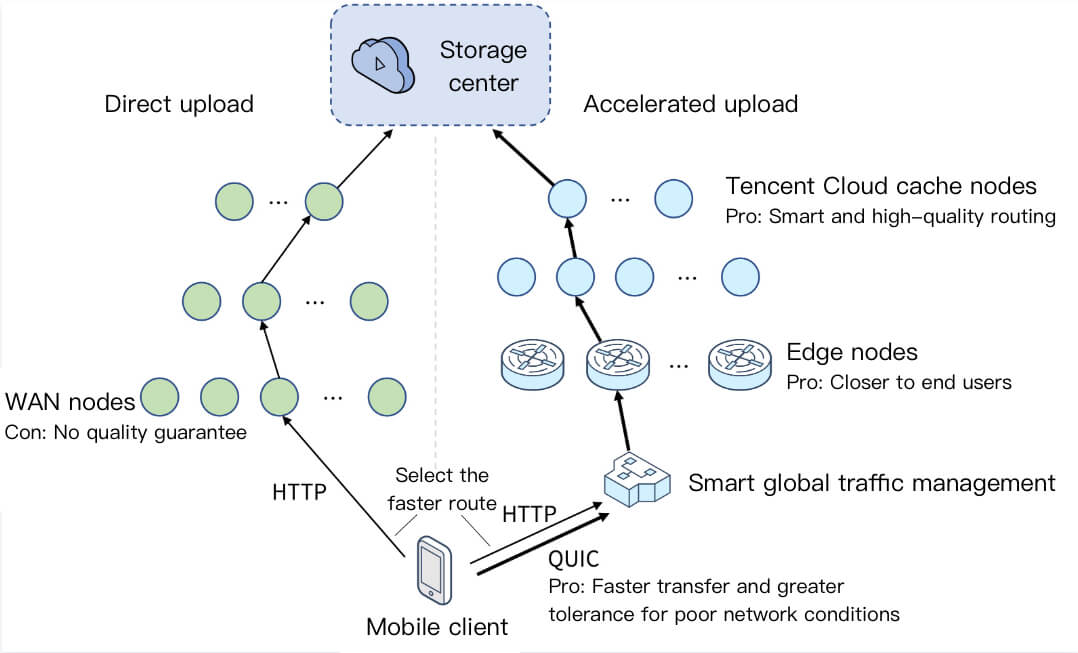客户端上传加速
最后更新时间:2022-09-15 17:35:34
客户端上传加速可为客户提供更高质量的上传服务。该功能基于腾讯云全球部署的加速网络,根据用户的请求,智能地选择最佳接入点和最优链路,提高上传的速度和成功率。同时支持使用 QUIC 协议进行数据传输,改善数据传输的效率和在弱网环境中的稳定性。
影响上传质量的主要因素
长距离传输
点播在全球很多地区部署了存储中心,客户可以选择性地启用这些存储中心,并且在上传时就近存储,详情参见 就近上传。但即便如此,还是无法避免一些终端用户与存储中心距离间隔太远,以及部分客户的业务场景中存在需跨地区甚至跨海上传的场景。长距离的数据上传通常就意味着更长的网络链路和更大的传输时延,而且一旦中间某一个环节出现网络抖动、丢包等问题,就会拉低整条链路的上传速度和成功率。
弱网问题
弱网简单来说就是质量较差的网络环境,如时延大、丢包率高的网络。如今移动网络普及甚广,移动端客户的上传量占比非常大。而移动网络的弱网问题十分常见,如用户处在基站信号覆盖较弱的地区,或者行动过程中联网设备频繁切换网络。如何在弱网环境中保持稳定的数据传输,是提高上传质量的一大难题。
网络协议效率不高
点播客户上传的文件大部分是数据量较大的视频文件,而目前在上传中使用最频繁的网络协议依然是 HTTP1.1。该协议本质还是基于串行模型,同时还存在队头阻塞等问题,在大规模数据传输的场景中,很容易触达性能瓶颈。
客户端上传加速的方案
全球链路加速,高保障通道
针对长距离传输场景,网络链路过长导致的上传质量不佳问题,云点播基于腾讯云遍布全球的加速网络和边缘节点,为客户提供一套数据上传的全球链路加速通道。借助腾讯云的智能全局流量管理平台,将用户的上传请求递交给最靠近用户的边缘节点,就近接收用户的数据。再通过腾讯云打磨多年的加速网络,选择最优链路,将数据传送到存储中心。
QUIC 协议,更快更稳定
针对弱网环境和网络协议效率不高的问题,云点播提供的客户端上传已支持 QUIC 协议。QUIC 协议是一种基于 UDP 实现的低延迟高可靠通信协议,目前标准的 HTTP3 协议正是基于 QUIC 实现的。QUIC 支持 0-RTT 建立连接和无队头阻塞的多路复用,可更大限度地利用网络带宽进行实际的数据传输,在丢包率和网络延迟较高的弱网环境也可提供高质量的数据通信。同时,QUIC 还支持连接迁移,在移动端频繁切换网络的场景中,也可平滑过渡,保证网络不中断。
智能择优,使用无门槛
云点播提供的上传加速方案简单易用,只需客户在控制台开启相关功能即可。在使用 SDK 进行上传时,会智能地在普通通道和加速通道中进行竞速和择优,同时会自动探测并决定是否使用 QUIC 协议进行数据上传。


使用方法
下面轻松两步,即可开启客户端上传加速功能:
1. 参照客户端上传加速的 控制台操作 指引,开启“全球链路加速”,并按需开启“QUIC 传输”。
2. Android 和 iOS 平台需确保在 App 启动时调用了 预上传 。若开启“QUIC 传输”,Android 平台需使用版本不低于 9.6 的 SDK,iOS 平台需使用版本不低于 10.4 的 SDK。
说明:
Android、iOS 上传 SDK,可同时支持上传加速和 QUIC 传输;
Web 端、小程序端上传 SDK,仅支持上传加速,当前暂不支持 QUIC 传输。
费用相关
使用客户端上传加速,将涉及以下费用:
全局链路加速费用:使用全局链路加速时,产生的上传加速流量费用
QUIC 传输费用:使用 QUIC 传输时,产生的上传加速流量费用
以上费用的具体价格,请参见 购买指南。
文档反馈

